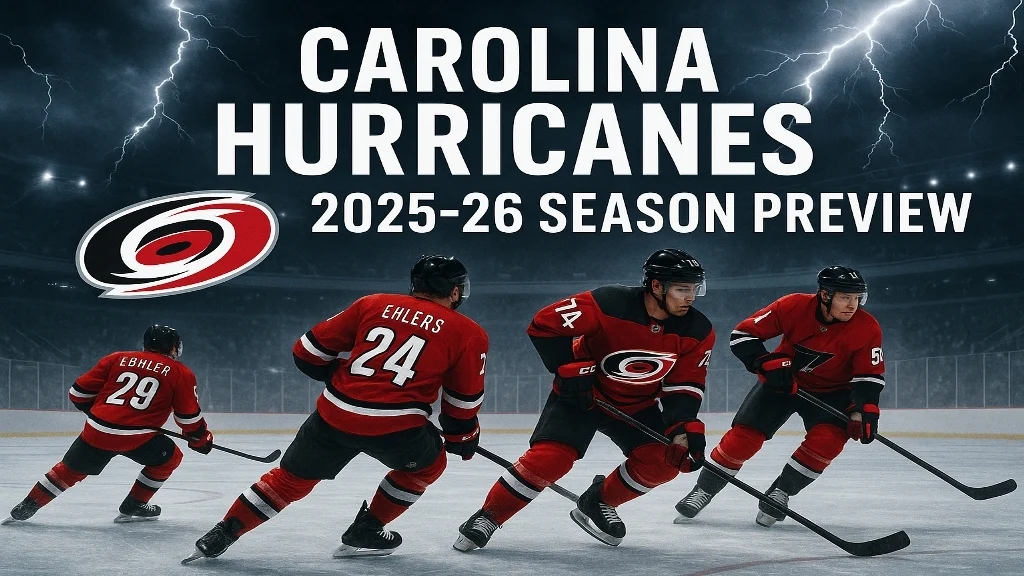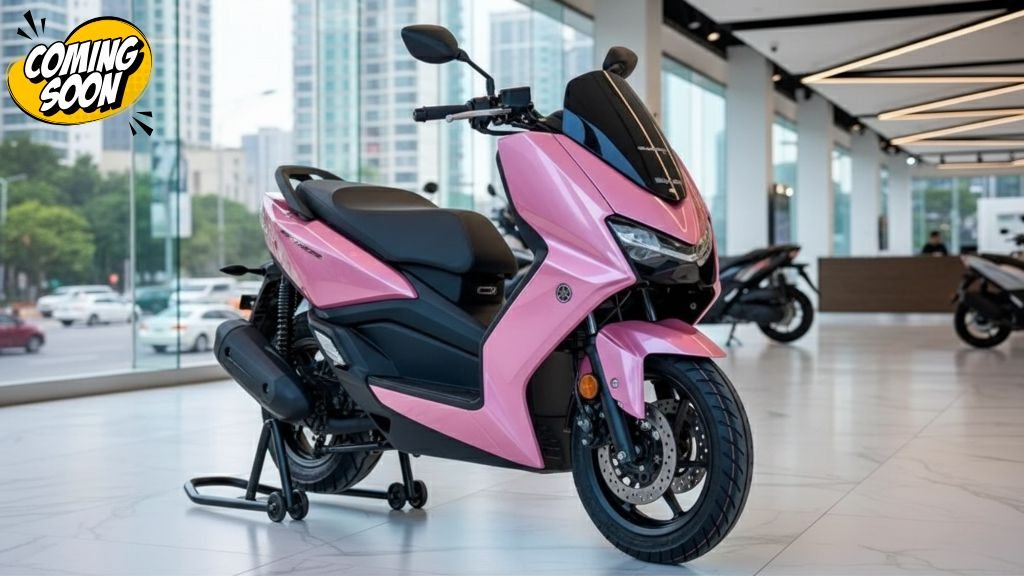The Carolina Hurricanes don’t rebuild; they reload. After a second straight year of deep playoff runs, a relentless forecheck, and a defense-first identity that strangles opponents, they enter 2025-26 with a familiar promise and a fresh edge. The headline is simple: add more burst up front, reconfigure the defense without losing structure, trust a proven coach and a sturdy goalie tandem, and finally push through the ceiling that has stopped them short of the Stanley Cup Final. The season preview from the league’s own newsroom lays out the blueprint: an Ehlers-powered top six, a reworked blue line around Jaccob Slavin, and one of the NHL’s most cohesive systems under Rod Brind’Amour.
| Snapshot | Detail |
|---|---|
| Last season | 47–30–5, 2nd in Metro; reached Eastern Conference Final |
| Head coach | Rod Brind’Amour (eighth season) |
| Big offseason add | Nikolaj Ehlers (6-year deal) |
| Blue line refresh | K’Andre Miller trade; Sean Walker, Shayne Gostisbehere in; Burns, Orlov out |
| Rising rookies | Bradly Nadeau, Alexander Nikishin |
| Goalie tandem | Frederik Andersen, Pyotr Kochetkov |
| Projected top line | Ehlers — Sebastian Aho — Seth Jarvis |
The 2024-25 foundation
Carolina’s 47–30–5 record and second-place Metro finish last year were more than just good—they were consistent with the Brind’Amour era. This team has now qualified for the playoffs every season under him and reached three Eastern Conference Finals in seven years (2019, 2023, 2025). That consistency is the core of their identity, and it’s why the Hurricanes are again projected near the top of the East. But the mission is unfinished. To take that next step, goals at five-on-five and a more dangerous look off the rush and on the power play have to be present in April and May, not just October through March.
Why Nikolaj Ehlers changes the math
Carolina doesn’t chase flashy names for the sake of headlines. But Nikolaj Ehlers is different; he’s a tactical fit. The 29-year-old winger brings speed that stretches defenses, edge-work that slices through neutral zones, and finishing touch off the rush. Across a decade in Winnipeg, he regularly hit the 25-goal mark, and his playoff pop last spring underscored why the Hurricanes moved to secure him on a six-year, $51 million contract. On a line with Sebastian Aho and Seth Jarvis, Ehlers can be the winger who turns sustained zone time into quick-strike goals—exactly the kind of playoff scoring punch Carolina has needed in tight series.
A new-look defense without losing the Carolina DNA
The back end looks different, and that was inevitable after two summers of churn. Brent Burns and Dmitry Orlov exited after last season, following the departures of Brady Skjei and Brett Pesce the summer before. To keep the structure intact, Carolina went younger, longer, and faster: the organization traded for K’Andre Miller and added right-shot Sean Walker while leaning on Jalen Chatfield’s growth.
Shayne Gostisbehere, a lefty with power-play utility, is expected to slide to the right when needed, and top prospect Alexander Nikishin, fresh from the KHL and a solid playoff cameo, is ready for real minutes. The constant is Jaccob Slavin’s quiet excellence and calm in chaos. This is still a defense tailored for aggressive gaps and fast breakouts; the names changed, the template did not.
The projected lineup tells a clear story
The penciled-in forward lines jump off the page because they mix burst, bite, and balance. Up top, it’s Ehlers—Aho—Jarvis, a trio that can tilt ice. The second unit leans on power: Andrei Svechnikov flanking emerging center Logan Stankoven with Jackson Blake’s pace on the other wing. The middle-six identity group remains intact with Jordan Staal holding down tough minutes next to Jordan Martinook and newcomer William Carrier, who brings straight-line physicality.
Depth looks sturdy with Eric Robinson, Jesperi Kotkaniemi, and former MVP Taylor Hall forming a fourth line that can actually win shifts. On defense, the pairings highlight choice and flexibility: Slavin with Walker, Miller with Chatfield, and Nikishin alongside Gostisbehere. In net, Frederik Andersen’s composure and Pyotr Kochetkov’s athleticism remain a tandem opponents respect.
What’s the biggest challenge?
Chemistry on the back end. Getting pairings to “click” is the first big to-do in camp. Balance the handedness, match pace with poise, and assign roles on both special teams. Because Carolina’s system asks defensemen to pinch smartly and recover even faster, misreads early can be costly. The good news is that Brind’Amour’s staff tends to solve these puzzles by Thanksgiving. The upside here is significant: Miller’s reach and skating, Walker’s retrievals, Nikishin’s two-way upside, and Gostisbehere’s quarterbacking give this unit layers it didn’t have last spring.
Special teams: more danger, less doubt
If there’s a step-change coming, it likely arrives on the power play. Ehlers’ one-touch pace and Jarvis’ timing at the bumper should open seams Aho can exploit. Gostisbehere’s vision up top offers another look when Slavin isn’t running the first unit. A second unit that features Svechnikov’s shot and Hall’s net drive doesn’t feel like a second unit at all. Penalty kill? With Staal and Martinook setting the tone and a mobile blue line behind them, Carolina has the personnel to stay top-tier. That’s the formula in spring: win the special-teams battle by one, and let five-on-five volume do the rest.
The Stankoven and Blake effect
Logan Stankoven is the kind of player Hurricanes fans fall for—a relentless motor, a knack for getting inside defenders, and enough skill to finish. Centering Svechnikov gives him space to create off the wall and attack the slot. Jackson Blake’s rise adds another dose of speed and touch. Together, they stretch the attack across three lines, which is what separates Carolina from most of the Metro. If either one pops for 20 goals, the Canes’ five-on-five model becomes a nightmare to defend.
The rookie with a chance to grab the spotlight
Bradly Nadeau is the “don’t blink” name in camp. He finished last AHL season on a heater, led Chicago in goals, and nudged into two NHL games with an assist. Whether he starts in Raleigh or becomes the first forward recall, his straight-line speed and shot profile fit exactly how Carolina wants to play. If he forces the issue, the Hurricanes’ top nine gets even more dangerous.
Goaltending: steady hands, calm hearts
Andersen and Kochetkov are not a novelty pairing anymore—they’re a proven one. Andersen’s economy of movement and Kochetkov’s explosive stops give Carolina two distinct looks that complement each other. With a deeper, faster defense in front of them, the volume of clean looks against should dip. If the tandem stays healthy, the Hurricanes can manage minutes smartly across the winter grind and enter the playoffs rested and ready.
Culture remains the secret sauce
You can’t quantify it easily, but you can feel it every spring: the Hurricanes’ dressing room is aligned. That starts with Jordan Staal wearing the “C,” and veterans like Martinook, Slavin, and Aho setting standards. It extends behind the bench, where Brind’Amour has built a system players trust. The result is buy-in across roles—stars backcheck, checkers push pace, defensemen activate, and everyone owns the wall battles. That’s why free agents like Ehlers and trade targets like Miller choose Raleigh: the hockey is honest, the expectations are clear, and deep runs feel possible every year.
The Metro chessboard and where Carolina fits
The Metropolitan Division is as nasty as ever. Pittsburgh still rides elite top-end talent, the Rangers can cook on special teams, the Devils are pushing speed, and Washington remains stubborn. That’s fine. Carolina’s path isn’t about dominating the division in December; it’s about collecting points consistently, staying healthy, and peaking as roles settle. If the Ehlers line becomes the threat it can be and the new defense pairs solidify by midseason, the Hurricanes project as a 105–110 point team with real President’s Trophy upside and, more crucially, a clear shot at winning the East.
What would success look like?
Three things. First, a power play that finishes in the league’s top 10. Second, the blue line pairings that reduce high-danger chances against late in games. Third, the emergence of one more difference-maker beyond Aho, Svechnikov, and Jarvis—whether that’s Ehlers at full wattage, Stankoven hitting another gear, or Hall turning back the clock for 25. If two of those three boxes are ticked by April, the Canes won’t just be favorites to win rounds; they’ll be favored to win the conference.
X-factors that could swing the season
Every contender has variables. Health, obviously. But also deployment: does Gostisbehere’s right-side shift hold up against top cycles? Does Miller’s length erase entries the way Carolina expects? Do Stankoven and Blake sustain production against top-six matchups over an 82-game slate? And can Kochetkov’s aggressive style be harnessed when whistles vanish in the playoffs? These are good problems; they’re the problems of a team aiming high.
Camp notes and momentum builders
Preseason is where the Hurricanes trial the pairings, test rookies, and tune the pace. The organization has already signposted how they’ll approach the exhibition slate, from youthful rosters early to more NHL-heavy looks as Opening Night approaches. Internal coverage out of Raleigh underscores the calm, process-first approach that has become a franchise staple this time of year. That rhythm matters when the regular season starts fast.
Predicted opening-night lineup (and why it works)
Carolina’s own projection points toward that Ehlers–Aho–Jarvis top line, Svechnikov with Stankoven and Blake on Line 2, and the Staal line as the matchup unit. On defense, Slavin–Walker as the go-to stopper pair, Miller–Chatfield for length and mobility, and Nikishin–Gostisbehere for puck movement and PP punch. Andersen gets the crease, Kochetkov the 1B. It’s a lineup that reads modern and mean: speed outside, muscle at center, and defense built to feed the rush.
Bottom line
The Carolina Hurricanes enter 2025-26 as a proven 100-point machine with a higher offensive ceiling thanks to Ehlers, a defense that’s been refreshed without losing its identity, and a coach who gets buy-in. They’ve been close. This group looks built to be closer still—and maybe, finally, all the way.
FAQs
What was the Hurricanes’ record last season and how far did they go?
They finished 47–30–5, second in the Metropolitan Division, and advanced to the Eastern Conference Final.
Who is the most important new addition?
Nikolaj Ehlers, whose speed and scoring add a different dimension to the top six and power play.
How did the defense change and why?
After veteran departures, the Canes traded for K’Andre Miller and added Sean Walker while elevating Alexander Nikishin and leaning on Jalen Chatfield. The idea is to stay fast and mobile without sacrificing structure.
What’s the likely goalie plan?
A tandem of Frederik Andersen and Pyotr Kochetkov, with Andersen’s calm and Kochetkov’s explosiveness providing complementary styles.
Which young players could break through?
Logan Stankoven already looks set for a big role, Jackson Blake can drive pace, and Bradly Nadeau is the prime candidate to force his way into the lineup during the year.







